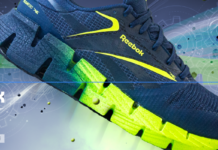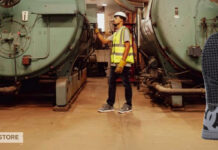Vital information:
We have some helpful tips about safety footwear features, fit, proper safety footwear selection and how to maintain your safety footwear. We’re here to also identify ways you can care for your feet as well as adding some tips about how to prevent foot discomfort.
The fit and selection of safety footwear are different for each and every person because everyone has a different perception of comfort – each foot has its own special requirements. Only the person wearing the shoe can determine the comfort level and specific needs that the boots or shoes must have. When finding the perfect pair of safety footwear, you must consider these issues: heat, moisture, pressure, friction, and bacteria.
Foot Health:
Heat exuded by foot temperature causes foot moisture, odors, and bacterial growth. Normal foot temperature is about 94 degrees Fahrenheit. The temperature inside a shoe can range from 105 to 120 degrees Fahrenheit. Although human beings couldn’t survive under these oppressive conditions, their feet do for many hours per day, 365 days of the year.
Let’s just admit it: your feet produce moisture. Feet have 125,000 sweat glands. Except for your hands and head, feet perspire more than any other part of the body. In fact, each foot gives off (at minimum) ½ pints of moisture per day. This amounts to almost two quarts per week and twenty-five gallons annually.
Foot perspiration is 98% water and 2% salts and acid. It’s the acidity that can do the most damage by corroding the shoes’ materials. The result is a shoe that can quickly age and as a result lose their good-looking, good-fit qualities. As you can see, those twenty-five gallons of foot moisture pouring into the shoes is a very important issue affecting overall foot comfort.
The pressure and friction from a shoe’s upper averages fifty-two pounds per square inch (PSI). The average person experiences 8,000 such frictions daily. The result can be calluses, corns, ingrown toenails, aches, and soreness.
Twelve percent or more than two trillion bacteria are found on the feet. Most bacteria are harmless but about five percent (100 billion) are potentially toxic. This is one of the reasons that skin infections such as rash, itching, etc. are more common on the foot than on any other part of the body.
A bacterium within footwear also corrodes the leather resulting in decreased shoe fit. To combat foot perspiration and bacteria, it’s important let the insides of shoes dry naturally, away from heat. Also look for removable inserts that can be replaced after time.
After considering these features of your safety footwear, you should be able to narrow down your selection. Now, it’s time to find a pair that fits perfectly.
Fitting Tips:
These guidelines will help facilitate you in finding the perfect pair.
- Select the shape of the foot
- Have both feet measured (most people don’t have the same exact size feet)
- Fit the largest foot
- Fit when feet are most swollen
- Obtain a good heel-to-ball fit
- Stand during the fitting process
- Avoid footwear that’s too tight
- Seek a good heel fit
- Walk to ensure a good fit
Like the rest of the body, feet change as a person gains and loses weight. As you age, your feet can get wider, flatter, and longer. The fat padding on the bottom of feet also begins to erode and not be replaced. What for years was comfortable may no longer be what your foot finds comfortable. Be open to the change, since a comfortable shoe can be priceless.
Footwear Maintenance:
Below are four basic steps that are easy to follow. Here are a few simple suggestions to keep your boots performing at their best for years to come:
- Clean
- Waterproof
- Condition
- Keep them away from heat!
Boots are made of leather because it’s comfortable, supportive, naturally water-repellent, and breathable. Once it gets wet, it stretches and weakens, shrinking and becoming brittle as it dries.
Cleaning:
The first step to boot maintenance is regular cleaning. Small particles of dirt can work their way into the fibers of the leather, causing it to dry out and break down. After wearing, rinse off any mud and dirt with tap water.
To remove oil-based dirt, excess wax, and stubborn grime that will not be cleaned by plain water, use a Footwear Cleaning Gel and a nylon brush. Be sure to clean the linings of your boots with a warm damp cloth after each use as well. Salt from perspiration can pass into the lining rapidly destroying the leather, making it dry and cracked.
Waterproofing:
This is important not just to keep your feet dry, but it will keep boots cleaner and maintain the leather’s suppleness for improved durability, too. After cleaning your boots with water, apply the appropriate a waterproofing treatment to the entire boot, paying special attention the stitching and hardware (anywhere the leather has been punctured) to ensure complete protection from the elements. Reapply as necessary or after use in severe conditions. For best results, let the work footwear dry for at least 24 hours before use.
Conditioning:
Conditioning boots can reduce the break-in time for new boots or revive old, dried out ones. We suggest using a leather conditioner a few times a year or as needed.
Drying:
Start by removing the laces and insoles. Dry the boots slowly at room temperature. Do not expose them to a direct heat source, as excessive heat can cause irreversible damage to the leather and is harmful to the adhesives used in boot construction.
To help dry a boot that has been filled with water or is thoroughly soaked, we recommend stuffing it with newspaper. Replace wet newspaper and repeat until boot is dry. There are also footwear drying products that can properly dry your them effectively and safely.
Stretching:
To reduce problems and discomfort with your feet, there are several ways to alleviate foot problems. You can improve circulation to your feet with a gentle foot massage, warm foot bath, raising your feet, or stretching. It’s also important to select and wear quality footwear.
Grab your toes by pulling them toward you for 10 seconds. Repeat this activity three or four times for each foot. Next, point and flex each foot four or five times. These simple exercises stretch the tendons and can help to reduce inflammation.
Foot Care Regimen:
Maintaining effective foot care is important to keep your feet feeling great and your boots working properly. The following suggestions will help increase your overall levels of comfort.
Keeping feet clean and dry is important to maintaining healthy feet. A daily check-in on your feet is an easy way to catch and prevent a simple problem from becoming a serious issue. Cutting the toenail straight across prevents the nail from possibly becoming ingrown. Wearing socks made from today’s performance fabrics are designed to pull moisture away from the feet, keeping them dry. A cotton sock holds moisture, keeping the foot damp and uncomfortable.
A performance fabric provides the best environment for healthy feet and also slows down the breakdown of shoe materials. Washing your feet daily is an easy way to maintain a healthy foot. If you notice any sores, pain, or changes with your feet, consult your medical professional.
Conclusion:
After following all these guidelines, you’ll be on a fast track to finding the best fit and the most comfortable pair of safety footwear. When you find the perfect pair, take care of them. Making them last is left up to you and how you care for them, so take pride in your safety footwear so they can continue to work just as hard as you do.




